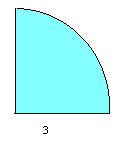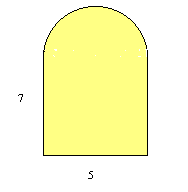Perimeter and Area
Section 6.1
Two dimensional figures are classified by the number of sides they have.
Polygon: Many sides
Pentagon: Five sides
Hexagon: Six sides
Octagon: Eight sides
Common figures:
Triangle: Three angles, three sides.
Quadrilateral: Four Sides
Specific Quadrilaterals:
Square: All sides equal, all angles 90 degrees.
Rectangle: Opposite sides equal, all angles 90 degrees.
Trapezoid: Two sides parallel
Parallelogram: Opposite sides equal and parallel.
Rhombus: Parallelogram with all sides equal.
Perimeter: the distance around a two-dimensional figure. The sum of the lengths of its sides.
Area: The number of square units it takes to fill the space of the figure.
Most areas are derived from the area of a rectangle.
Height refers to the perpendicular length with respect to the base of the figure.
Exercise 1:
Find perimeter and area of the following:
Area of Rectangle = (base)(height)
Area of Triangle = ½ (base)(height)
Area of Parallelogram = (base)(height)
Area of Trapezoid = ½ (b1 + b2) (height)
Right Triangles: A triangle with one angle = 90 Degrees.
|
Pythagorean Theorem In a right triangle with c , length of hypotenuse (opposite 90 degree angle) and a, b are lengths of the legs, then a2 + b2 = c2
|
Exercise 2:
Find the perimeter and area of a right triangle
hypotenuse = 13 ft and one leg = 12 ft
Circle: the set of all points equidistant from fixed point. The fixed point is the center. The line segment from the center to any point on the circle is the radius. So the equidistance is the radius. Any line segment that connects any two points on the circle and passes through the center is the diameter.
Since circles are a special figure ( not a polygon) we don’t call the distance around it the perimeter, it’s called the circumference.
The circumference of any circle is always slightly more than 3 of its diameters. The value is a constant called pi
p ~ 3.14……
Circumference = pd
diameter = 2 radius,
Given a circle with radius, r, then
Circumference = 2pr
Area of circle = pr2
Exercise 3:
Find the Area and perimeter of the figure shown.

Exercise 4:
Total area = Area of Rectangle + Area of semicircle

Perimeter = ½ circumference + base + 2(height)
Back to Finance, Geometry and Logic Main Page
Back to the Survey of Math Ideas Home Page
Back to the Math Department Home Page
e-mail Questions and Suggestions